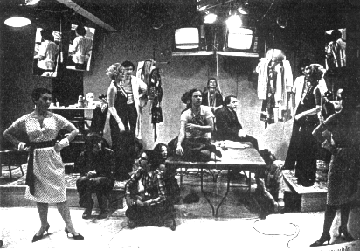
The Performance Group's Marilyn Project
Michael Kirby was the most outspoken exponent of formalist theater and founded the Structuralist Workshop in the 1960s to explore this style of performance. He called it "Structuralist" (capitalizing the term popularized by Levi-Strauss) in order to make a distinction between his emphasis on spatial and temporal form (i.e. structure) and the historical association of formalism with styles and abstraction:
| Structuralist theatre works with structure in a formal way and makes structure -- the relationship between the parts -- the most important aesthetic element in the performance. Since the relationship between the parts exists to a great extent in time, and since it involves connections between moments or sections of the play through or over or across time, this kind of formalism tends to involve time more than the present moment, the mind more than the eye or ear. |
| -- Michael Kirby, A Formalist Theatre |
Repetition soon became a key concept to the Structuralist Workshop as a way of making structure tangible. Iowa City consisted of projections of photographs taken simultaneously by three different photographers at three different positions. For example, a rowboat on a lake was simlutaneously photographed from the three vertices of a large equilateral triangle (each photographer moved twice for a total of nine different angles of the same scene). During the peformance, these images were projected behind two people in winter clothes who sat in a metal rowboat in the center of the stage. As they played out their "scene," recordings of conversation and ambient noise from the day of the shoot were played, creating a symmetrical relationship between the scene as recorded/photographed and the scene as played. This kind of mirrored performance reached its peak with the cult revival performances of "The Rocky Horror Picture Show" and was used recently in the Wooster Group's production of House/Lights. A particularly symmetrical example of this technique is the Performance Group's Marilyn Project, which used two casts performing the same play simultaneously in order to shift the audience's focus from narrative to structure, namely the minute differences of performance and the impossibility of replication. In Kirby's words:
| Repetition of identical, like, or similar elements is perhaps the basic kind of nonsemiotic discontinuous structure. When a phrase, gesture, or object reappears more than once, it has the tendency to invoke, at some point, the expectation that there will be another. Thus repetition "jumps" in both directions on the time continuum, relating disparate points in an alogical fashion. |
| -- Michael Kirby, A Formalist Theatre |

The Performance Group's Marilyn Project
Back to Structuralism | Forward to Tesselations
Page author: Max Dana